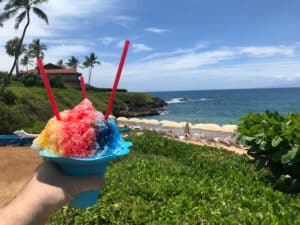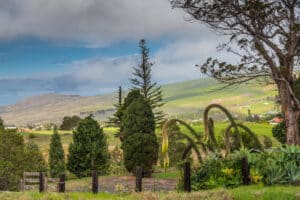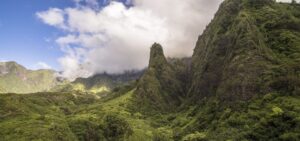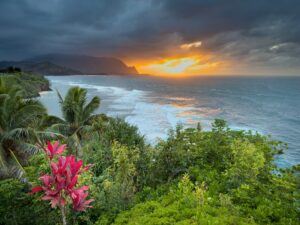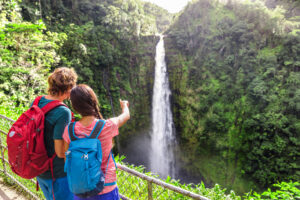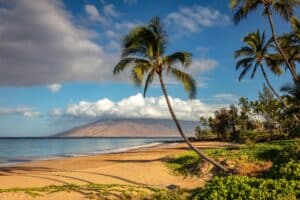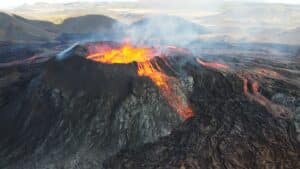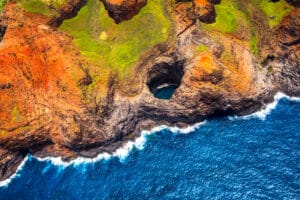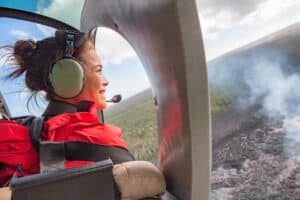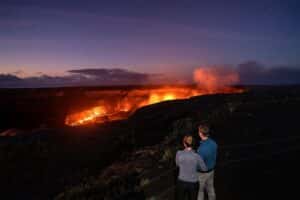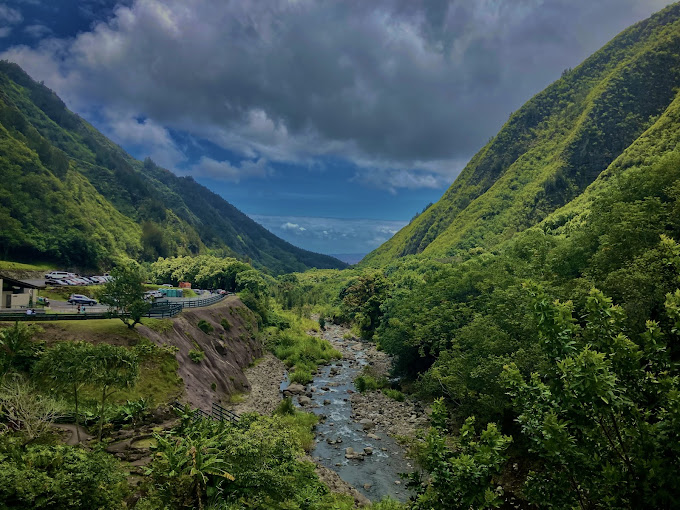
‘Iao Valley State Park (Photo Credit: State of Hawaii)
Nestled in the heart of West Maui, ʻĪao Valley is a lush sanctuary brimming with natural splendor, cultural significance, and centuries of history. Part of the West Maui Mountains and designated the Iao Valley State Park, this 4,000-acre lush valley welcomes visitors to its dramatic landscapes of towering emerald peaks, its storied past, and its spiritual resonance. The soaring ʻĪao Needle and the area directly around it is referred to as the ʻIao Valley State Monument.
ʻĪao Valley beckons all those who enter to slow down, breathe deeply, and reflect on the connection between land, people, and legacy. It’s a place to be intentional and be enveloped by nature.
Geographic and Natural Wonders
ʻĪao Valley is located about three miles west of Wailuku in Central Maui not far from the airport. This narrow valley cuts deep into the mountains and stretches about 10 miles inland.
“To call this West Maui Mountains park ‘lush’ is an understatement of epic proportions. Its dense rainforest canopy makes this popular park one of America’s more unique, dominated by the Iao Needle — a 1,200ft vegetation-covered lava remnant that rises from the valley floor to a higher height than the Eiffel Tower” — Thrillist

‘Iao Needle (Photo Credit: State of Hawaii)
The ʻĪao Needle
At the heart of the park lies the Kuka‘emoku, more commonly known as the ʻĪao Needle. It’s the most iconic natural feature of the valley. Even though the ʻĪao Needle isn’t as recognizable to tourists as Diamond Head, most native Hawaiians will be able to identify the ʻĪao Needle instantly.
The towering green spire rises 1,200 feet from the valley floor and 2,250 feet above sea level. It’s often shrouded in mist and clouds with a lava remnant formed by the volcanic forces that created the island itself. Centuries of erosion from water and wind carved it into its current grandeur. While geologists classify it as a basaltic spire left behind by erosion, its significance to Hawaiians goes far beyond its physical formation.
To ancient Hawaiians, the needle may have served as a natural altar or navigation point. Its size and prominence made it a marker of the valley’s sacred energy. Today, it serves as a visual focal point for hikers, photographers, and nature lovers who trek into the valley to witness its majesty firsthand.
A Botanist’s Dream
The entire valley is a tropical oasis and one of the wettest places in Hawai’i. Thanks to Maui’s abundant rain and warm climate, ʻĪao is cloaked in a mysteriously dense fog and lush vegetation. Towering koa trees, feathery ferns, wild guava, and swaying bamboo dress her.
Rare native plants thrive in the valley because of the fertile volcanic soil and consistent stream of freshwater that flows through it — the ʻĪao Stream. This fresh water resource has long sustained both the valley’s ecosystem and the Hawaiian communities that have lived nearby.
With its cool climate, high rainfall, and elevation, the valley supports a unique microclimate within Maui. The heavy rains etch deeper into the valley each year. Frequent cloud cover adds an ethereal quality to the already breathtaking views.
Historical Significance of Īao Valley State Park
ʻĪao Valley is not only a place of natural beauty. It is also one of Hawai’i’s most historically and culturally significant sacred sites to visit.
A Royal Burial Site
This valley is a sacred site that was once kapu (forbidden) to all but Hawaiian royalty. The sheer, inaccessible cliffs in `Iao Valley were a burial site for Hawai’i’s ali’i (royalty) for centuries. It was a place where the bones of chiefs were hidden to prevent them from falling into enemy hands. These ancient burials underscore the valley’s spiritual significance and link to mana — the spiritual power believed to be contained in sacred landscapes and ancestral remains. It is currently open to tourists, but advanced reservations are required.
The Battle of Kepaniwai
One of the most notable historical events in Hawaiian history is associated with ʻĪao Valley. It was the Battle of Kepaniwai in 1790. During this bloody conflict, King Kamehameha I invaded Maui in an attempt to unite the Hawaiian Islands under one ruler. The battle took place in the narrow confines of the valley with Kamehameha’s warriors facing the forces of Maui’s chief, Kalanikūpule. The steep terrain and the dense foliage turned the valley into a brutal battlefield.
According to oral accounts, the clash was so intense and the casualties so high that the Iao Stream ran red with the blood of the fallen warriors. The name “Kepaniwai” translates to “the damming of the waters,” recounting how the bodies choked in the stream. Ultimately, Kamehameha emerged victorious. He was aided in part by Western firearms and cannons introduced by foreign advisors. This victory was a pivotal moment in his eventual conquest and unification of the Hawaiian Islands.
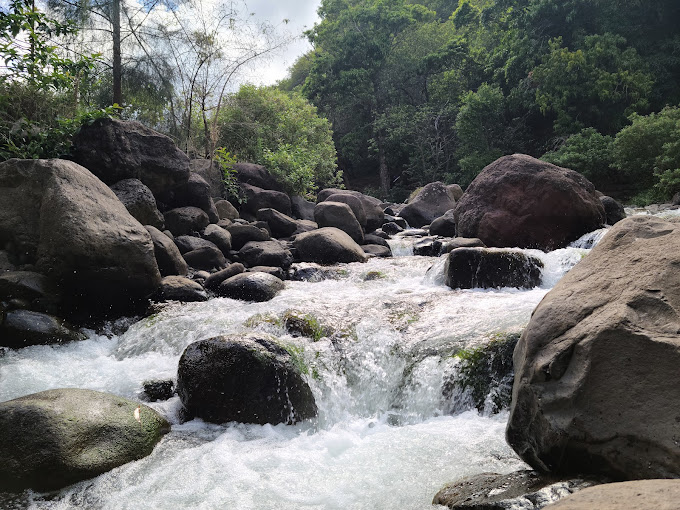
The ‘Iao Stream runs clear today. (Photo Credit: State of Hawai’i
To learn more about the Battle of Kepaniwai click here.
Find out more about the history of King Kamehameha I.
Cultural and Spiritual Importance of Īao Valley State Park
ʻĪao Valley is deeply woven into the fabric of Hawaiian spirituality and cultural identity. The valley is wahi pana, a “storied place” imbued with mana and ancestral connection. Its role as a royal burial site and battleground enhances this sacred aura.
But even without knowledge of its history, the natural beauty of the valley inspires reverence. The dramatic cliffs, the lush foliage, and the ever-changing mist evoke a sense of something greater — a serene atmosphere and a living presence in the land itself.
How to Visit ʻĪao Valley State Monument and the ʻĪao Needle
Managed by the Hawaii State Parks Division, the ʻĪao Valley State Monument offers a serene and accessible experience for travelers of all ages. The main trail is a short, paved loop leading to a viewing platform that overlooks the ʻĪao Needle and valley floor. Interpretive signs along the way provide historical and cultural context to those who aren’t familiar with the story of ʻĪao Valley.
The paved pathway and 135 steps to the Iao Needle Viewpoint is relatively easy and scenic, with greenery and fresh, mountain streams meandering down the steep slopes into the valley floor. It’s a must-visit if you have an hour or two to spare in Maui.
For those looking for a deeper immersion, longer hikes can be taken along adjacent trails or through unofficial footpaths. If you are not familiar with the valley, these should be approached with care and respect for the land. The West Maui Mountains can generate flash floods quickly, so it’s crucial to be aware of weather conditions before venturing too far from marked paths.
There are picnic areas and educational displays that share the valley’s ecological and historical narratives. In recent years, the State of Hawaii has implemented restoration efforts to preserve native plant species and control the spread of invasive ones like guava and ginger.
How to Visit Īao Valley State Park
- Non-residents: Must make advance reservations for entry and parking.
- Hawaii residents: Are exempt from the fee/reservation requirement but need to show proof of residency (Hawaii driver’s license or ID) at entry.
- Reservations: Are accepted up to 30 days in advance.
- Fees: Non-residents are $10 each, which includes parking. Children 3 and under are free. The fee is $5 for non-residents entering with a Hawaii state resident.
- Website: Go Hawaii State Parks.
Getting To ‘Iao Valley: It’s Easily Accessible
- Driving: From Wailuku, head west on Ka’ahumanu Avenue (HI-32) and follow signs for Iao Valley State Park.
- Public Transportation: The Maui Bus operates routes to ‘Iao Valley. Catch routes #20 or #35 from Kahului or Wailuku.
- Parking: Parking is available in a lot at the park entrance, located at 54 ‘Iao Valley Road.
Exploring Īao Valley State Park
- ‘Iao Needle: A well-marked, paved pedestrian path leads to the ‘Iao Needle lookout point.
- Hiking: ‘Iao Valley State Park offers several hiking options, including a short, family-friendly paved trail and longer, less-traveled paths. If you are planning to hike, take adequate water, wear sturdy shoes (trails get muddy here), pack a light sweatshirt for layers, bring sunscreen and bug spray, have a fully charged cellphone, and let someone know where you’re going. Sudden rain showers are common in Maui.
Other Attractions Near Īao Valley State Park
Consider visiting Kepaniwai Park and Heritage Gardens, a beautiful public park containing displays that honor the multicultural history that contributed to modern Maui.

Kepaniwai Park and Heritage Gardens. (Photo Credit: Maui County)
Circle M Ranch, formerly Mendes Ranch, offers guided horseback riding along a coastal valley trail with views of the Pacific Ocean in Wailuku.
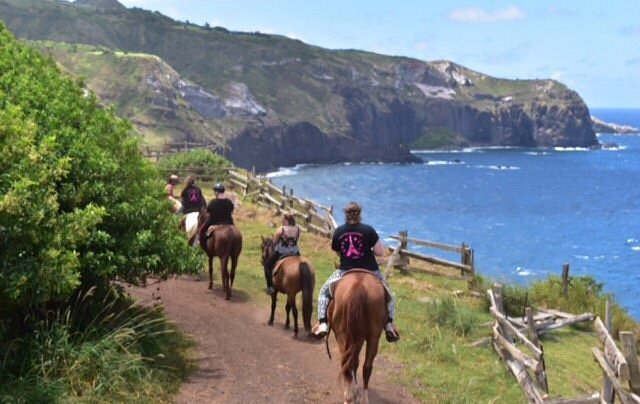
Horseback riding at Circle M Ranch (Photo Credit: Circle M Ranch)
Take the tram tour at Maui Tropical Plantation to learn how sugarcane and pineapples grow on this tropical working farm in Wailuku.
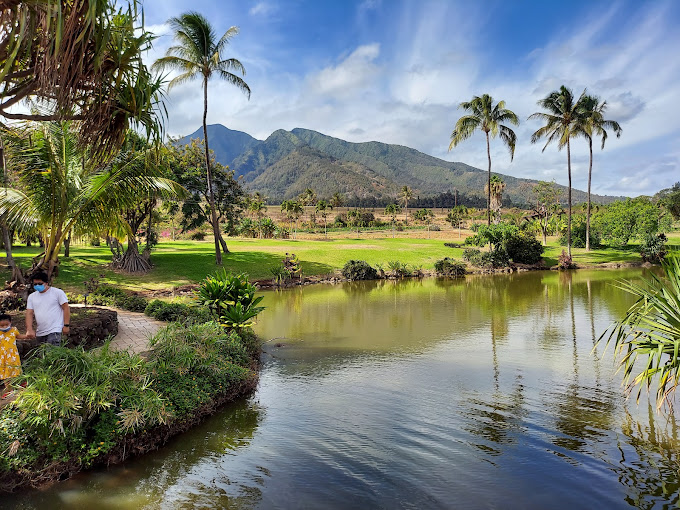
Maui Tropical Plantation. (Photo Credit: Maui Tropical Plantation)
Stewardship and Respect
As tourism continues to grow in Hawaii, places like ʻĪao Valley face increasing degradation from foot traffic, litter, and erosion. Native Hawaiians and conservationists have asked for greater respect, education, and environmental stewardship in these sacred sites.
Visitors should follow basic guidelines rooted in kuleana (responsibility) and malama ʻāina (care for the land):
- Stay on designated paths to prevent erosion and damage to native plants.
- Avoid making noise or causing disturbances — the valley is a place of spiritual reflection.
- Do not swim or wade in the Iao stream. It’s sacred ground and can also be dangerous.
- Leave no trace — pack out everything you bring in.
- Learn about the culture and history of Maui before your visit to deepen your appreciation.
In return, ʻĪao Valley offers something rare and meaningful — a moment of connection to nature, history, and something beyond the self.
Parting Reflections
ʻĪao Valley is more than a postcard-perfect destination. It is a living, breathing testimony to the beauty and complexity of Hawai‘i’s natural world and the resilience of its people. Whether you go for the views, the history, the spiritual energy, or simply the fresh air, ʻĪao Valley has a way of leaving its mark on the soul.
Standing before the ʻĪao Needle, surrounded by mist and mountains, it’s easy to understand why this lush valley has been a sacred place for generations. It speaks to the timeless rhythm of the islands — a reminder that nature is not just something to admire or explore, but something to honor and protect

